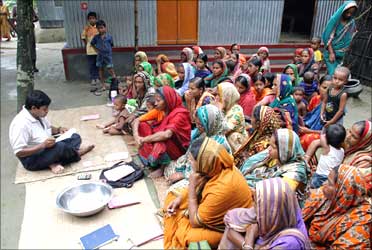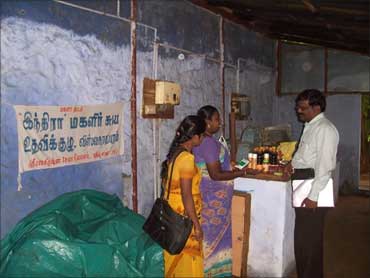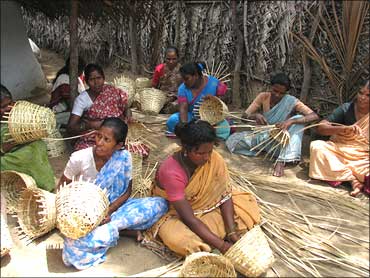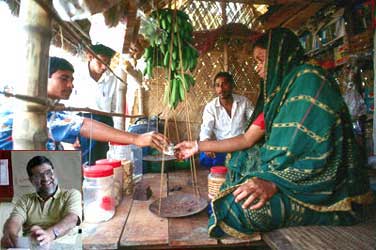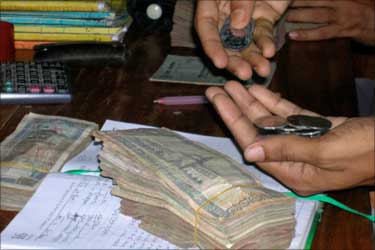 | « Back to article | Print this article |
Microfinance in India. How skewed is the system?
On October 14 this portal reported that 30 microfinance borrowers in Andhra Pradesh have recently committed suicide.
At about the same time offices of several micro finance companies in AP were attacked and vandalised by people protesting exorbitant interest rates and harassment by loan collectors.
Is this just a dark edge to efforts for ensuring 'inclusive markets' and 'financial inclusion'? Or do these events call for serious introspection about these buzz terms?
At present the flurry of accusations and explanations about the microfinance sector is dominated by operational details - questions about what are 'valid' costs and profits vs. profiteering.
Similarly,the uproar for or against the ordinance issued by the AP government, to address the problems in microfinance, is mostly focused on the operational implications of a sector that has been growing exponentially.
In 2008-09, outstanding loans of microfinance institutions increased by 97 per cent over the previous year to Rs 11,734 crore (Rs 117.34 billion).
Note: All photographs are for representative purpose.
Click on NEXT to read more...
Microfinance in India. How skewed is the system?
It would seem that little or no attention is being devoted to the most fundamental question: what are the merits and dangers of being 'included' in a global financial system that is in deep crisis.
A few months before the meltdown of 2008 Dr. Venkatraman Anantha Nageswaran, who is now chief investment officer of Bank Julius Baer, offered an explanation for why microfinance is attracting large volumes of global capital.
And, this is not just because the poor have become famous for great pay-back rates.
What is more significant is that loan portfolios of MFIs tend to be relatively unaffected by the turmoil in the global economy which has traditional asset classes like equities and bonds, which in turn are subject to grave volatility.
This makes the poor an attractive diversification opportunity for well-heeled investors.
"It logically follows that rich investors could thus have a stake in entrenched poverty for if the poor cease to exist, they would cease to provide uncorrelated returns to international investors.
One way to entrench poverty is to lend them too much and for too many existent and nonexistent needs," Nageswaran wrote in the journal Microfinance Insights.
Nageswaran is also one of the founders of the Aavishkaar India Micro Venture Capital Fund.
Click on NEXT to read more...
Microfinance in India. How skewed is the system?
A study conducted by the Centre for the Study of Financial Innovation (CSFI), titled Microfinance Banana Skins 2008: risk in a booming industry, highlighted the risk of micro finance growing too fast and for the wrong reasons.
Fast paced growth has been accompanied by a fall in quality of management capability and skills.
As this happens, the study warned, there is a danger of aggressive lending through loan-products that could drive people deeper into poverty - such as loans for consumption of luxury goods that will put the borrower in a debt trap.
Events of the last few weeks seem to indicate that these fears of "mission drift" have become reality in some parts of India.
The original mission of microfinance institutions which grew out of local self-help groups (SHGs) is to primarily do-good.
To provide access to working capital at affordable rates to those who are too poor to be served by conventional banks.
Profits from such micro-lending companies are seen as a by-product to be ploughed back to benefit still more people.
Click on NEXT to read more...
Microfinance in India. How skewed is the system?
In this model a high quality of institutional capacity building (ICB) is considered mandatory.
This means that the MFI invests both in the financial literacy of its borrowers and in the quality of systems through which borrowers are chosen.
It has been widely reported that ICB standards have fallen with the growth of those NBFCs which are characterized by the push for quick growth and high profits.
Aloysius P Fernandez, a highly respected proponent of the SHG model, last week circulated a paper titled 'Is Micro Finance Lending a Macro Mess?'
He noted that a flat rate of 26 per cent interest is now common among NBFCs and asked how many of the poor are in a position to earn returns of 80 per cent in order to pay back the loan and the interest and still be left with a profit for themselves.
After all, there are few takers for loans of over 15 per cent interest in the private organised sector.
Fernandez went on to point out that not-for-profit MFIs with a low cost model have broken even and earned adequate surpluses at interest rates of 16-17 per cent declining.
Why then is it assumed that only a so-called 'market driven' model of much higher returns will meet the credit needs of the entire population?
Click on NEXT to read more...
Microfinance in India. How skewed is the system?
Fernandez, who is chairperson of Nabard Financial Services, favours a subsidised model of inclusion in which the emphasis is not merely on credit but on creating dispersed wealth through various forms of value addition and asset creation.
In the absence of this just exponential growth of micro loans cannot be equated with 'financial inclusion'. It is more likely to result in potentially fatal indebtedness of the kind now being reported in AP.
These issues and anxieties have been heatedly debated within the microfinance community for well over a decade.
The Microfinance Institutions Network (MFIN), which released a voluntary code earlier this year, has been making a serious effort to self-regulate and facilitate orderly growth of the sector.
But there are grave doubts about MFIN's ability to enforce its own code.
Meanwhile the ordinance issued by AP government, aimed at controlling excesses of NBFCs, has thrown even community-based SHGs into turmoil. But the travails of regulation are a sub-plot.
Click on NEXT to read more...
Microfinance in India. How skewed is the system?
The big story is the profits that are expected from the 'poverty market'.
M S Sriram, an independent researcher, recently wrote in the Economic and Political Weekly that high valuations of MFIs indicate that "the poverty market is here to stay, for more entrepreneurs to enter it and capitalize on the high returns."
Those high returns would not be a problem if there is an accompanying expansion of productive assets at the base of the economy.
News of acute distress among borrowers shows that the opposite is happening in too many cases.
But it is not enough to say that the MFI sector pause and introspect.
All proponents of 'inclusive markets' need to similarly pause and reflect on how surpluses are flowing in the economy, where they are coming to settle more deeply and why.
Otherwise, as Anantha Nageswaran wrote two years ago, we could be faced with a most tragic outcome: "The poor, instead of being beholden to a local lender would now be indebted to a double-breasted international investment banker."
